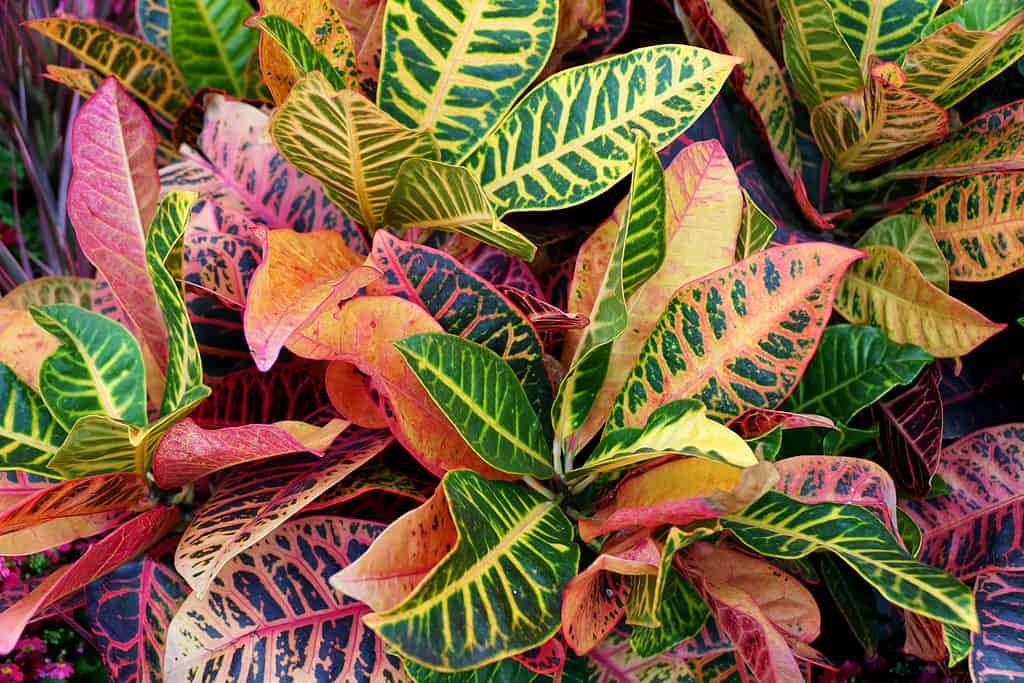The Petra croton is a beloved indoor plant with deep green leaves. It’s also quite easy to care for! Often referred to as the croton Petra or Codieaum variegatum ‘Petra,’ this plant is prized for its particularly variegated foliage. Croton’s foliage can range from red to orange and yellow to bright green. It’s one of the most popular varieties of Codieaum variegatum out there, and for good reason. It’s not too difficult to care for and can be planted indoors or outdoors.
In this guide, we’ll break down everything you need to know about the Petra croton, from its origin to its growth requirements to common problems plant parents tend to run into with the Petra. Growing a Petra croton doesn’t have to be difficult, and its maintenance to keep it fresh and vibrant can actually be quite fun.
What is a Petra Croton?
The Petra croton, also known as the croton Petra, is a variety of Codiaeum variegatum. Its botanical name is Codiaeum variegatum ‘Petra.’ It is a member of the Codiaeum genus and Euphorbiaceae family.
This plant is a tropical evergreen shrub that is indigenous to the western Pacific islands and countries in southern Asia. It can only be grown in USDA hardiness zones nine through 11 and enjoys hot, muggy climates. The Petra croton may be grown in pots and maintained indoors over the winter in other climates. All temperature zones require specific care to maintain the health of this unusual, variegated plant when grown indoors. In the right conditions, this slow grower can reach up to eight feet tall within a few years.
So what makes the Petra croton special from the dozens of croton varieties? Like many other croton varieties, it has a rainbow hue to it but can also grow in more of a yellow-green hue. It all depends on the amount of sunlight it is given. Brightly lighted areas are ideal for this lovely tropical plant to grow. Their variegated leaves will take on additional rainbow hues as they receive more sunlight. Warm stripes of red, pink, orange, and yellow typically contrast with dark or bright green. They are surprisingly simple to maintain and will stay bright and vibrant as long as they receive adequate outside and inside maintenance. They are also pretty easy to maintain, making them great for beginner plant parents.

The Petra croton (pictured) can boast a wide range of colorful hues in its leaves.
©Khairil Azhar Junos/Shutterstock.com
Petra Croton Sunlight Requirements
In moderate to bright indirect sunshine, the Petra croton plant will develop colorful leaves. Although it can withstand less light, its leaves will continue to be green and not sport colorful variegation without lots of sunlight. It needs around four to six hours of indirect sunlight each day to stay lively and beautiful.
To prevent burned leaves when grown outside in USDA hardiness zones 10 through 12, ensure your Petra croton receives some afternoon and evening shade. This plant may shed leaves if moved from indoor to outdoor. Continue to look after it, and it should eventually recover. As we’ve noted in many of our articles on Codiaeum variegatum, this species and its many varieties tend to be dramatic about their surrounding conditions.
Petra Croton Water Requirements
The Petra croton plant requires moderate upkeep. If the top one to two inches of its soil adheres to your finger, there is no need to water, as it has adequate moisture. If the leaves are thirsty, they will often droop or even drop. Flush the plant with warm, filtered, and dechlorinated water. If your plant is in a grower pot, let the water drain entirely before putting it back in a decorative pot. When the topsoil of this variety of croton becomes dry once more, repeat this watering routine. As development slows down in the winter, reduce watering. Crotons generally go somewhat dormant in the winter, so overwatering can become an issue.
Due to its origins in the humid tropics of Southeast Asia, Southern India, and Australia, this indoor plant prefers environments similar to those found there. To keep this plant adequately hydrated and content, add humidity to its leaves and surrounding area by spritzing it with a spray bottle, setting up a humidifier, or filling a pebble tray with water and placing it beneath the plant.
Petra Croton Temperature Requirements
Crotons prefer temperatures between 60 degrees F and 80 degrees F because they enjoy warmer climates that are comparable to their native environment. In the winter, keep this houseplant away from drafts or cold air, such as areas near your air conditioners or drafty windows. Dry or chilly air may slow development for Petras or even harm your plant in extreme cases. Never allow your Petra croton to be exposed to temperatures under 50 degrees F. This is not a cold hardy plant!

Petras (pictured) can grow well outdoors between 60 and 80 degrees F.
©suttirat wiriyanon/Shutterstock.com
Petra Croton Fertilizer Requirements
For the best development and plant health in the spring and summer, fertilize your Petra’s soil with an organic fertilizer once a month. During the plant’s resting season in the fall and winter, stop fertilizing altogether. Although feeding your plants can seem overwhelming at first, it is a simple process once you get going. A liquid plant fertilizer will make the process much more simple with no need to disturb your Petra’s soil.
What are the Benefits of Keeping a Petra Croton?
To start, this plant is excellent at purifying air. According to a well-known NASA study, the croton plant effectively eliminates VOCs. The EPA claims that the toxins in our indoor air are far greater than those in the air we breathe outside. A Petra croton may not only bring moisture and freshness to the air inside your home or office, but it also looks quite sharp while doing so.
Outside of its air purification properties, the Petra croton is great for increasing humidity in dry, indoor spaces. As this plant requires misting and extra humidity to thrive, giving it the water it needs will result in higher humidity in your home.
That all being said, the main benefit of keeping a Petra croton is simply that it is a pretty plant that can pull a room together. Who needs more than that, really?
Should I Repot My Petra Croton?
When the roots begin to show through the drainage holes, repot your Petra. Repot your plant in a container that is two inches wider than the previous pot sometime around early spring, if possible. However, if your Petra croton is in serious need of repotting, the season does not matter. To avoid any soggy roots, use potting soil that has good drainage. Your Petra croton may object by losing part of its leaves after being repotted. This plant’s shock response may be common given how sensitive it is to environmental changes. With some tender loving care, it should thrive with fresh green growth within a few weeks.
Common Growth Problems with Petra Crotons
The fungal diseases anthracnose and canker, as well as the bacterial infections crown gall and leaf spot, can all affect Petra croton plants. Pruning off all affected portions of the plant is necessary to control these diseases, all of which show swelling on the plant’s stems, leaf veins, and roots.
Lesions on the leaves that are dark brown and black can be used to identify leaf spot. A bactericide with copper can be used as a standard treatment, but if the plant is severely affected, then you might have to cut your losses and grow a new Petra. If your plant has anthracnose, you’ll see water spots that turn tan and occasionally have black specks in the middle. If a copper-based fungicide isn’t successful in treating the problem, all affected plants must be removed as they will spread to other plants quite quickly.
Pests such as gnats, mealybugs, mites, scales, whiteflies, and occasionally aphids must also be watched out for by Petra croton owners. Due to their small size, you might need a magnifying lens to see any of these insects. Fortunately, pesticides are quite efficient against insects when used as directed on the product label and with the required safety measures. Just as well, misting your plant’s leaves will knock these pests off in the early stages of infestation.
Ongoing Maintenance for Petra Crotons
If you take good care of your Petra croton, its gorgeous leaves will stay healthy for several years. You can do a few things beyond watering and providing sunlight to your Petra to keep it healthy.
To keep your Petra croton at a specific height or form, or to get rid of any dead leaves, prune it semi-regularly. With a clean blade and ideally during the dormant season (winter, generally), remove any old, brown, or broken leaves from the plant’s base. Avoid pruning them when they are in the height of their growing season. Doing so can do more harm than good.
Trim off any discoloration or imperfections in your Petra’s foliage by adhering to the natural lines and form of the leaf if only a tiny area of a leaf is damaged, such as the margins or tips.
We mentioned earlier the benefits of misting your Petra to boost humidity. Misting is also beneficial for removing dust, as the leaves of this plant can get quite dusty. You might consider using a moist towel to clean off its leaves if it is really dusty. This is a fantastic technique to repel leaf-munching pests as well.
Are Petra Crotons Toxic?
If consumed, this houseplant will make people, dogs, and cats sick and possibly cause mouth irritation. Drooling, vomiting, and diarrhea may present in animals that consume this plant. As a general rule of thumb, this plant should be kept away from pets and children. Wear gloves when handling the plant or pruning it since the white sap that is produced by its stem can irritate the skin even if not consumed.
Petra crotons are an excellent variety to choose from if you’re willing to put in the work and replicate its natural habitat in terms of temperature, humidity, and sunlight. It’s quite a stunner that will look beautiful both indoors and outdoors, with color schemes that seem to change from plant to plant. Why not grow your own Petra croton today?
Want to learn more about the incredible croton plant? Take a look at our complete guide to everything croton-related!
The photo featured at the top of this post is © iStock.com/SOMNATH MAHATA
FAQs (Frequently Asked Questions)
How tall does a Petra croton get?
When planted outdoors, this variety can reach eight feet tall and six feet wide.
Are Petra crotons easy to care for?
Petra crotons are relatively low-maintenance houseplants.
Is the Petra croton a species of croton plants?
No. The Petra croton is classified as Codiaeum variegatum ‘Petra’, meaning it is a variety instead of a unique species.
Thank you for reading! Have some feedback for us? Contact the AZ Animals editorial team.






